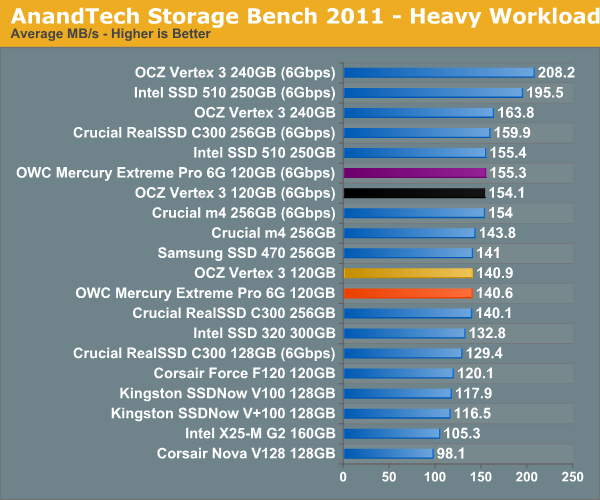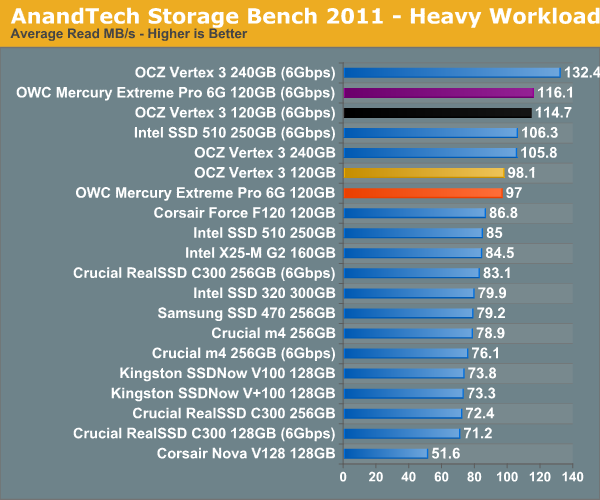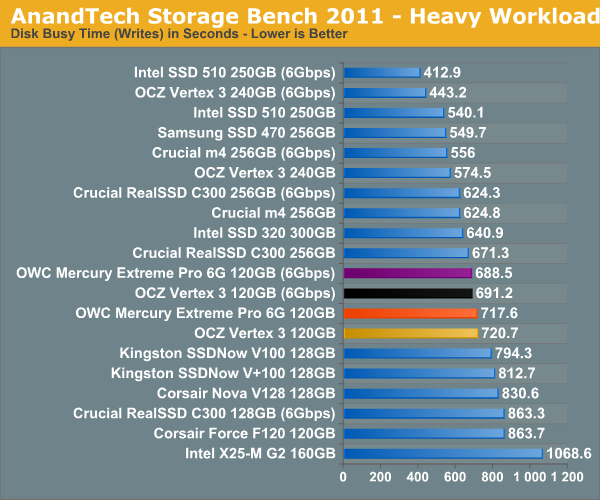OWC Mercury Extreme Pro 6G SSD Review (120GB)
by Anand Lal Shimpi on May 5, 2011 1:45 AM ESTAnandTech Storage Bench 2011
I didn't expect to have to debut this so soon, but I've been working on updated benchmarks for 2011. Last year we introduced our AnandTech Storage Bench, a suite of benchmarks that took traces of real OS/application usage and played them back in a repeatable manner. I assembled the traces myself out of frustration with the majority of what we have today in terms of SSD benchmarks.
Although the AnandTech Storage Bench tests did a good job of characterizing SSD performance, they weren't stressful enough. All of the tests performed less than 10GB of reads/writes and typically involved only 4GB of writes specifically. That's not even enough exceed the spare area on most SSDs. Most canned SSD benchmarks don't even come close to writing a single gigabyte of data, but that doesn't mean that simply writing 4GB is acceptable.
Originally I kept the benchmarks short enough that they wouldn't be a burden to run (~30 minutes) but long enough that they were representative of what a power user might do with their system.
Not too long ago I tweeted that I had created what I referred to as the Mother of All SSD Benchmarks (MOASB). Rather than only writing 4GB of data to the drive, this benchmark writes 106.32GB. It's the load you'd put on a drive after nearly two weeks of constant usage. And it takes a *long* time to run.
I'll be sharing the full details of the benchmark in some upcoming SSD articles but here are some details:
1) The MOASB, officially called AnandTech Storage Bench 2011 - Heavy Workload, mainly focuses on the times when your I/O activity is the highest. There is a lot of downloading and application installing that happens during the course of this test. My thinking was that it's during application installs, file copies, downloading and multitasking with all of this that you can really notice performance differences between drives.
2) I tried to cover as many bases as possible with the software I incorporated into this test. There's a lot of photo editing in Photoshop, HTML editing in Dreamweaver, web browsing, game playing/level loading (Starcraft II & WoW are both a part of the test) as well as general use stuff (application installing, virus scanning). I included a large amount of email downloading, document creation and editing as well. To top it all off I even use Visual Studio 2008 to build Chromium during the test.
Update: As promised, some more details about our Heavy Workload for 2011.
The test has 2,168,893 read operations and 1,783,447 write operations. The IO breakdown is as follows:
| AnandTech Storage Bench 2011 - Heavy Workload IO Breakdown | ||||
| IO Size | % of Total | |||
| 4KB | 28% | |||
| 16KB | 10% | |||
| 32KB | 10% | |||
| 64KB | 4% | |||
Only 42% of all operations are sequential, the rest range from pseudo to fully random (with most falling in the pseudo-random category). Average queue depth is 4.625 IOs, with 59% of operations taking place in an IO queue of 1.
Many of you have asked for a better way to really characterize performance. Simply looking at IOPS doesn't really say much. As a result I'm going to be presenting Storage Bench 2011 data in a slightly different way. We'll have performance represented as Average MB/s, with higher numbers being better. At the same time I'll be reporting how long the SSD was busy while running this test. These disk busy graphs will show you exactly how much time was shaved off by using a faster drive vs. a slower one during the course of this test. Finally, I will also break out performance into reads, writes and combined. The reason I do this is to help balance out the fact that this test is unusually write intensive, which can often hide the benefits of a drive with good read performance.
There's also a new light workload for 2011. This is a far more reasonable, typical every day use case benchmark. Lots of web browsing, photo editing (but with a greater focus on photo consumption), video playback as well as some application installs and gaming. This test isn't nearly as write intensive as the MOASB but it's still multiple times more write intensive than what we were running last year.
As always I don't believe that these two benchmarks alone are enough to characterize the performance of a drive, but hopefully along with the rest of our tests they will help provide a better idea.
The testbed for Storage Bench 2011 has changed as well. We're now using a Sandy Bridge platform with full 6Gbps support for these tests. All of the older tests are still run on our X58 platform.
AnandTech Storage Bench 2011 - Heavy Workload
We'll start out by looking at average data rate throughout our new heavy workload test:

Overall performance is identical to the 120GB Vertex 3, but still behind the 240GB version due to the use of single-die NAND devices. At 240GB the choice is clear, but at 120GB I'm still waiting to get my hands on a few more drives before determining the best buy at that price point.
The breakdown of reads vs. writes tells us more of what's going on:


The next three charts just represent the same data, but in a different manner. Instead of looking at average data rate, we're looking at how long the disk was busy for during this entire test. Note that disk busy time excludes any and all idles, this is just how long the SSD was busy doing something:













44 Comments
View All Comments
Anand Lal Shimpi - Thursday, May 5, 2011 - link
Those drivers were only used on the X58 platform, I use Intel's RST10 on the SNB platform for all of the newer tests/results. :)Take care,
Anand
iwod - Thursday, May 5, 2011 - link
I lost count of many times i post this series. Anyway people continue to worship 4K Random Read Write now have seen the truth. Seq Read Write is much more important then u think.Since the test are basically two identical pieces of Hardware, but one with Random Write Cap, the results shows real world doesn't show any advantage. We need more Seq performance!
Interestingly we aren't limited by the controller or NAND itself. But the connection method, SATA 6Gbps. We need to start using PCI-Express 4x slot, as Intel has shown in the leaked roadmap. Going to PCI-E 3.0 would give us 4GB/s with 4x slot. That should be plenty of room for improvement. ONFI 3.0 next year should allow us to reach 2GB+ Seq Read Write easily.
krumme - Thursday, May 5, 2011 - link
I think Anand heard to much to Intel voice in this ssd story4k random madness was Intel g2 business
And all went in the wrong direction
Anand was - and is - the ssd review site
Anand Lal Shimpi - Thursday, May 5, 2011 - link
The fact of the matter is that both random and sequential performance is important. It's Amdahl's law at its best - if you simply increase the sequential read/write speed of these drives without touching random performance, you'll eventually be limited by random performance. Today I don't believe we are limited by random performance but it's still something that has to keep improving in order for us to continue to see overall gains across the board.Take care,
Anand
Hrel - Thursday, May 5, 2011 - link
Damn! 200 dollars too expensive for the 120GB. Stopped reading.snuuggles - Thursday, May 5, 2011 - link
Good lord, every single article that discusses OWC seems to include some sort of odd-ball tangent or half-baked excuse for some crazy s**t they are pulling.Hey, I know they have the fastest stuff around, but there's just something so lame about these guys, I have to say on principle: "never, ever, will I buy from OWC"
nish0323 - Thursday, August 11, 2011 - link
What crazy s**t are they pulling? I've got 5 drives from them, all SSDs, all perform great. The 6G ones have a 5-year warranty, 2 longer than all other SSD manufacturers right now.neotiger - Thursday, May 5, 2011 - link
A lot of people and hosting companies use consumer SSD for server workload such as MySQL and Solr.Can you benchmark these SSD's performances on server workload?
Anand Lal Shimpi - Thursday, May 5, 2011 - link
It's on our roadmap to do just that... :)Take care,
Anand
rasmussb - Saturday, May 7, 2011 - link
Perhaps you have answered this elsewhere, or it will be answered in your future tests. If so, please forgive me.As you point out, the drive performance is based in large part upon the compressibility of the source data. Relatively incompressible data results in slower speeds. What happens when you put a pair (or more) of these in a RAID 0 array? Since units of data are alternating between drives, how does the SF compression work then? Does previously compressible data get less compressible because any given drive is only getting, at best (2-drive array) half of the original data?
Conversely, does incompressible data happen to get more compressible when you're splitting it amongst two or more drives in an array?
Server workload on a single drive versus in say a RAID 5 array would be an interesting comparison. I'm sure your tech savvy minds are already over this in your roadmap. I'm just asking in the event it isn't.